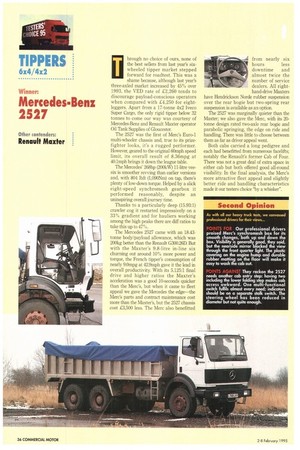TIPPERS
Page 38

If you've noticed an error in this article please click here to report it so we can fix it.
6x4/4x2
151 hrough no choice of ours, none oi the best sellers from last year's sixwheeled tipper market stepped forward for roadtest. This was a shame because, although last year's three-axled market increased by 45% over 1993, the VED rate of £2,260 tends to discourage payload-conscious operators when compared with £4,250 for eightleggers. Apart from a 17-tonne 4x2 Iveco Super Cargo, the only rigid tipper below 32 tonnes to come our way was courtesy of Mercedes-Benz and Renault Maxter operator Oil Tank Supplies of Gloucester.
The 2527 was the first of Merc's Euro-1 multi-wheeler chassis and, true to its prizefighter looks, it's a rugged performer. However, geared to the original 60mph speed limit, its overall result of 8.36mpg at 40.1mph brings it down the league table.
The Mercedes' 268hp (200kW) 11-litre veesix is smoother revving than earlier versions and, with 804 lbft (1,090Nm) on tap, there's plenty of low-down torque. Helped by a slick eight-speed synchromesh gearbox it performed reasonably, despite an uninspiring overall journey time.
Thanks to a particularly deep (15.93:1) crawler cog it restarted impressively on a 33% gradient and for hauliers working among the high peaks there are diff ratios to take this up to 47%.
The Mercedes 2527 came with an 18.43tonne body/payload allowance, which was 200kg better than the Renault G300.26D. But with the Maxter's 9.8-litre in-line six churning out around 10% more power and torque, the French tipper's consumption of nearly 9.0mpg at 42.9mph gave it the lead in overall productivity. With its 5.125:1 final drive and higher ratios the Maxter's acceleration was a good 10-seconds quicker than the Merc's, but when it came to fleet appeal we gave the Mercedes the edge—the Merc's parts and contract maintenance cost more than the Maxter's, but the 2527 chassis cost £3,500 less. The Merc also benefitted from nearly six hours less downtime and almost twice the number of service dealers. All righthand-drive Maxters have Hendrickson Norde rubber suspension over the rear bogie but two-spring rear suspension is available as an option.
The 2527 was marginally quieter than the Maxter; we also gave the Merc, with its 20tonne design rated two-axle rear bogie and parabolic springing, the edge on ride and handling. There was little to choose between them as far as driver appeal went.
Both cabs carried a long pedigree and each had benefitted from numerous facelifts; notably the Renault's former Cab of Four. There was not a great deal of extra space in either cab but both offered good all-round visibility. In the final analysis, the Merc's more attractive fleet appeal and slightly better ride and handling characteristics made it our testers choice "by a whisker".
































































































